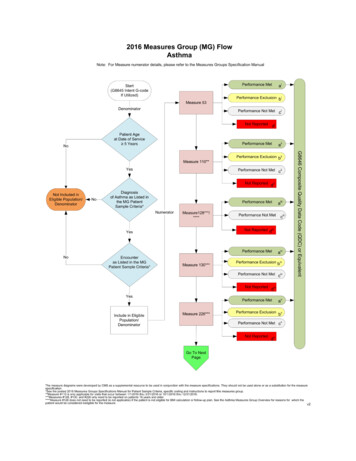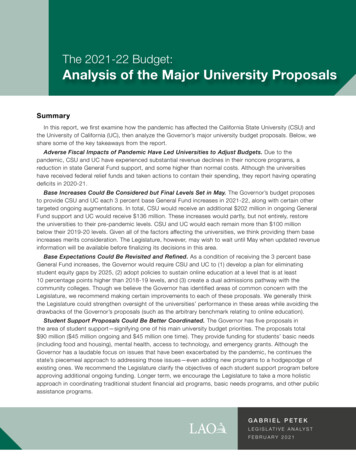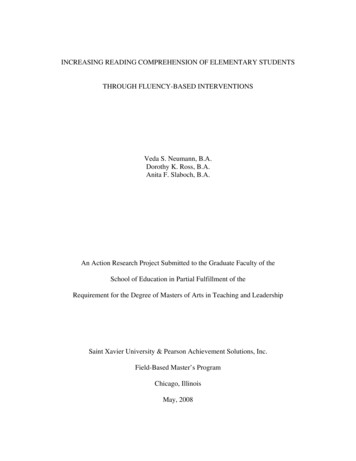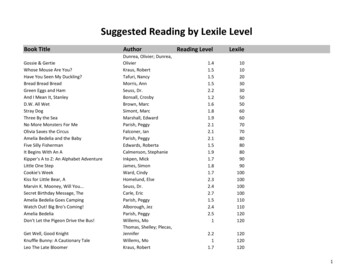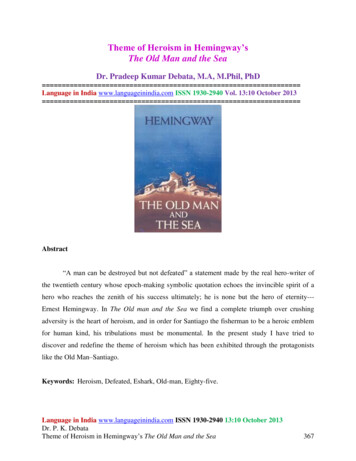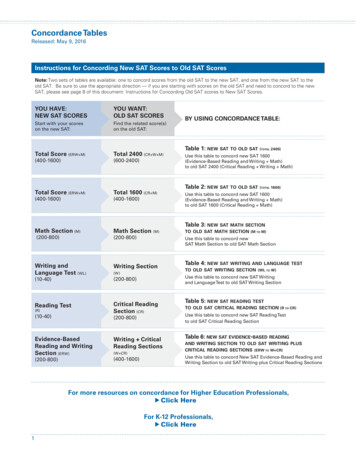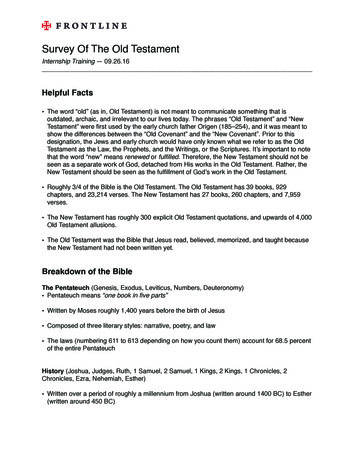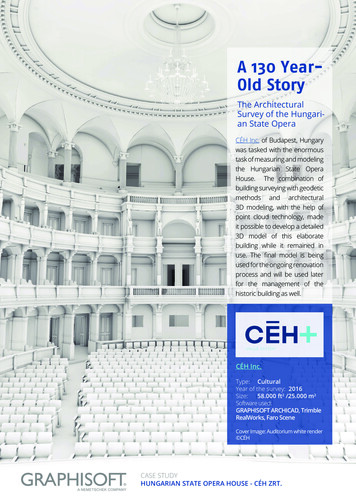
Transcription
A 130 YearOld StoryThe ArchitecturalSurvey of the Hungarian State OperaCÉH Inc. of Budapest, Hungarywas tasked with the enormoustask of measuring and modelingthe Hungarian State OperaHouse. The combination ofbuilding surveying with geodeticmethods and architectural3D modeling, with the help ofpoint cloud technology, madeit possible to develop a detailed3D model of this elaboratebuilding while it remained inuse. The final model is beingused for the ongoing renovationprocess and will be used laterfor the management of thehistoric building as well.CÉH Inc.Type: CulturalYear of the survey: 2016Size:58.000 ft2 /25.000 m2Software used:GRAPHISOFT ARCHICAD, TrimbleRealWorks, Faro SceneCover Image: Auditorium white render CÉHCASE STUDYHUNGARIAN STATE OPERA HOUSE - CÉH ZRT.
360 view of the Auditorium Hungarian State OperaHungarian State Opera HouseA 130-year-old storyThe decision to build the Hungarian Opera House was made in1873. Following a public tender, the jury selected the designsubmitted by famed Hungarian architect, Miklós Ybl (1814-1891).Construction of the neo-classical building began in 1875 and,despite minor delays, was completed nine years later. The openingnight – to which Emperor and King Franz Joseph was also invited –was held on September 27, 1884.Miklós Ybl’s neo-renaissance palace has remained virtuallyunchanged in the 130 years since, and continues to attractadmirers of opera and ballet alike with its repertoire and worldclass acoustics. Each year, thousands of tourists visit the buildingto take in one of Budapest’s most impressive 19th century nationalmonuments.CASE STUDYHUNGARIAN STATE OPERA HOUSE - CÉH ZRT.
Building survey and its challengesSurveying ProcessVideo by CÉHCÉH’s assignment was to complete a survey of the Hungarian StateOpera House and its other buildings (shop, sales center, offsitestorage, rehearsal hall, warehouses, offices and workshops) and,based on the point cloud data, to develop an architectural modelof the current state of the buildings.The collected data was processed using Trimble RealWorks 10.0and Faro Scene 5.5.It is important to note, that obtaining the data took considerablyless time than to process it. Even though data processingtook place essentially in tandem with the survey, the building’scomplicated structure and spaces, as well as the complexity of theproject made processing a lengthy task.The tandem surveying and processing workflow caused additionaldifficulties. Every newly-received point cloud detail had to beperfectly fit into the developing model based on the previouspoint cloud material. There was no time to update the alreadysubmitted materials.Given the fact that the survey was done while the Opera Housewas in use, it was impossible to survey whole building blocks intheir entirety. There were inaccessible rooms and the warehouseshad to be vacated. This meant many rounds of surveying until acertain building block could be finished. The result was a slowersurvey and registration process that also required significantadministrative work.CASE STUDYHUNGARIAN STATE OPERA HOUSE - CÉH ZRT.
The assembled point cloud mergedtogether with the ARCHICAD 19 model CÉHAlthough there were many spheres and checkerboards on hand,the Opera’s workers would accidentally move these tools, whichprevented the surveyors from later aligning the point clouds. Astime passed, however, the two crews got used to each other, andeveryone’s work proceeded more smoothly.“Managing the files wasgreatly helped by usingGRAPHISOFTBIMcloud, whichprovided access to thefile from practicallyanywhere in the world,at good speeds.”Gábor Horváth,lead architect, CÉHCertain spaces in the building (like the props warehouse) werealways changing, or else the surfaces of these spaces were toocomplex for the measuring instruments (e.g. the rigging systemcovered by a steel mesh, black surfaces backstage), whichhampered the process of obtaining exact measurements.The most difficult and time-consuming part of the job was surveyingthe vaulted, sometimes zig-zag spaces, which constitute theauxiliary and mechanical areas of the building on the lower levels.The elevations, too, presented the surveyors with similar vaultedstructures – the legacy of the original 19th century architect, MiklósYbl.CASE STUDYHUNGARIAN STATE OPERA HOUSE - CÉH ZRT.
The props and other equipment often obscured key surfaces, suchas walls and floors. In these cases, survey results can be the baseof only a very rough 3D model. Photos and videos would provevery useful in documenting the details of the spaces not accessibleby the scanner.The raw measurement data was imported to Faro Scene 5.5 forpre-processing and Trimble RealWorks 10.0 for finalizing themeasurements, which took considerable time; the exportedpoint cloud files were also very large. Both types of data are veryhardware-intensive.Point cloud detail of themain Auditorium andthe attic space above it CÉHThe same detail modeledin ARCHICAD 19 CÉHCASE STUDYHUNGARIAN STATE OPERA HOUSE - CÉH ZRT.
Managing the point cloud libraryThe point cloud shown in TrimbleRealWorks CÉHFile size is a significant factor in terms of data management. Sincean enormous amount of point clouds was produced and the pointcount was as high as 40 million points per room, it was impossibleto connect them as they were. First, the point-count had to bereduced using Trimble RealWorks. After this process, a digit couldbe cut off; the team ended up connecting smaller point clouds of3-4 million points.Blocks of 20-30 million points were then assembled and savedfrom these reduced point clouds with the maximum density of1 point per sq cm. This size is still dense enough and containsenough detail for the modeling work done in ARCHICAD.After the registered and reassembled point cloud file wasexported in E57 format, readable by the design software, theteam of architects could begin their work.ARCHICAD 19 was a significant asset in the modeling process.Managing the files was greatly helped by using GRAPHISOFTBIMcloud, which provided access to the file from practicallyanywhere, at acceptable speeds. This was no small achievement,since the full project file exceeded 50 Gb.CASE STUDYHUNGARIAN STATE OPERA HOUSE - CÉH ZRT.
The final ARCHICAD model insection view CÉHModel developmentAnalysis of the building’s 3D mass began with the help of an old 2Dsurvey plan. This 2D material was refined and augmented by thepoint cloud.The main deviations from the available 2D plans were obviousfrom the beginning. The building’s stories, with their many andvaried levels, presented the most challenges. A renovation in 1984introduced new, more modern structures (such as steel supportsfor the rigging system). The availability of these renovation planshelped in understanding the complex steel structures, since thesurveying equipment was not capable of detecting certain narrowelements clearly and understandably. The same was true for theconstantly moving parts of the building – such as the steel stagestructure - which remained in use during the survey.CASE STUDYHUNGARIAN STATE OPERA HOUSE - CÉH ZRT.
Almost every geometry could be modeled with ARCHICAD. Verycomplex elements, like the statues, were created in other softwareand then imported into ARCHICAD as triangulated 3D surfaces(Meshes). The polygon-count of these elements is very high, sothey were added to the model in the final stage.Statues of the façade shown in theARCHICAD model CÉHThe architects’ biggest constraint in this case was hardwarecapacity. Both the point cloud and the model file tended to bevery large, which made file management more difficult.With smart tricks, library and layer management, a smaller filesize could be achieved that made it possible to deal with themodel more easily. An important issue was to purge embeddedlibrary elements, since they increase the file size, which may notbe a problem with a smaller model, but in this case the originalgeometry was already a high-polygon one. Another importantissue was to save redundant elements as Objects in order toreduce file size and to make the 2D navigation smoother. This way,one Object could be placed as many times as needed, instead ofmultiple Morphs or other elements. Of course, this didn’t reducepolygon-count so 3D performance wasn’t affected fundamentally,but it did affect file size and the 2D-handling of the file. This couldbe refined even more with simple 2D symbols defined for theObjects.CASE STUDYHUNGARIAN STATE OPERA HOUSE - CÉH ZRT.
Rendered façade of the finalARCHICAD model CÉHWith smart layer combinations – for example, by making it possibleto switch off the polygon-heavy decorative elements – 3D-navigationand additional 3D modeling became more manageable.Finally, the many hours of work and effort paid off with the result:a building model that anyone can explore on their own device.This success required the surveying process to be planned andscheduled in detail, since the surveyors could not always accessall parts of the building. Continuous and effective work on thesurveying and modeling tasks required the dedicated, consistentcooperation between the staff of the Hungarian State OperaHouse and the CÉH team of engineers who are proud that theirachievement serves to support the preservation and renovation ofthe building and of Hungarian culture.CASE STUDYHUNGARIAN STATE OPERA HOUSE - CÉH ZRT.
BIMx Lab videoThe Hungarian State Opera’ssurvey model shown in BIMx LabModel: CÉHPresentation video made byGRAPHISOFTThe Opera model in BIMx LabAlthough the ARCHICAD model was smartly optimized to be easilymanageable for all possible uses, the full final model still containsclose to 27,5 million polygons and approximately 29,000 BIMelements.This BIM model size was hardly manageable with GRAPHISOFT’smobile product, BIMx.The recently published BIMx Lab, a technology preview versionof BIMx, was optimized so that it can handle huge and detailedmodels with polygon-counts previously unimagineable.According to the BIMx development team, when using the newBIMx engine, the size limitation moves back to ARCHICAD; everymodel ARCHICAD can handle is easily navigable in BIMx Lab!Download the BIMx Lab app from the Apple App Store (technologypreview).To experience its capabilities, the BIMx Lab model of the HungarianState Opera House has been made available as well.CASE STUDYHUNGARIAN STATE OPERA HOUSE - CÉH ZRT.
About CÉH Inc.CÉH Planning, Developing and Consulting Inc. – as the leadingengineering business of the CÉH Group – is a key player in theHungarian planning and development market. During over 25years of operation, CÉH has amassed significant experience inthe preparation, planning and construction of buildings and theproject management services associated with implementation.CÉH employ a team of professionals covering all engineeringactivities associated with all development and design disciplines.CÉH has some 80 full-time employees as well as over 10 affiliatesand 150-200 contracted partners to provide comprehensiveservices for its clients.They have carried out projects involving multiple engineeringtasks in a large number of complex development projects at anational scale where they single-handedly delivered the full rangeof engineering services to their clients.Due to CÉH’s personnel having several years of domestic as well asinternational experience, they are able to manage the entire BIMprocess. Their efforts are confirmed by the success of a portfolioconsisting of more than 150.000 m2 in implemented BIM projects.CÉH Inc.’s architects have been using ARCHICAD for more than10 years. They currently have 26 seats and use BIMcloud as well.Three- seven architects worked on the case study project usingARCHICAD 19.CASE STUDYHUNGARIAN STATE OPERA HOUSE - CÉH ZRT.
CAS ST HAIA STAT OA HOS - CÉH T Hungarian State Opera House A 130-year-old story The decision to build the Hungarian Opera House was made in 1873.


